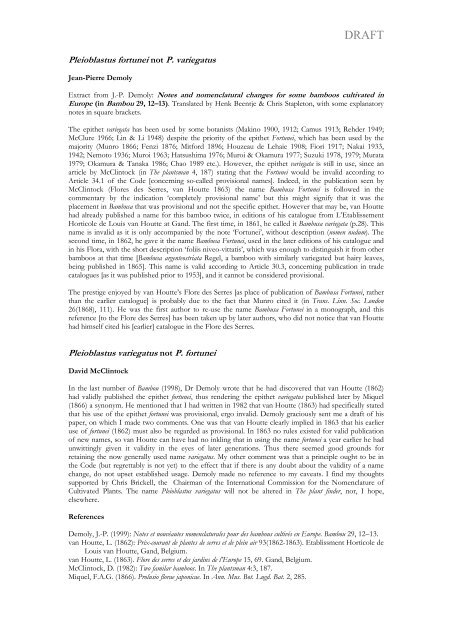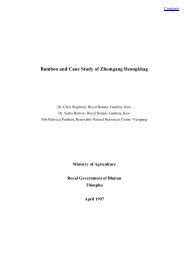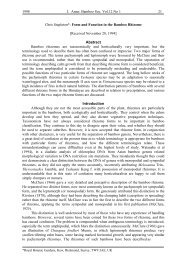Bambusa fortunei and Bambusa variegata: competing names
Bambusa fortunei and Bambusa variegata: competing names
Bambusa fortunei and Bambusa variegata: competing names
You also want an ePaper? Increase the reach of your titles
YUMPU automatically turns print PDFs into web optimized ePapers that Google loves.
Pleioblastus <strong>fortunei</strong> not P. variegatus<br />
Jean-Pierre Demoly<br />
DRAFT<br />
Extract from J.-P. Demoly: Notes <strong>and</strong> nomenclatural changes for some bamboos cultivated in<br />
Europe (in Bambou 29, 12–13). Translated by Henk Beentje & Chris Stapleton, with some explanatory<br />
notes in square brackets.<br />
The epithet <strong>variegata</strong> has been used by some botanists (Makino 1900, 1912; Camus 1913; Rehder 1949;<br />
McClure 1966; Lin & Li 1948) despite the priority of the epithet Fortunei, which has been used by the<br />
majority (Munro 1866; Fenzi 1876; Mitford 1896; Houzeau de Lehaie 1908; Fiori 1917; Nakai 1933,<br />
1942; Nemoto 1936; Muroi 1963; Hatsushima 1976; Muroi & Okamura 1977; Suzuki 1978, 1979; Murata<br />
1979; Okamura & Tanaka 1986; Chao 1989 etc.). However, the epithet <strong>variegata</strong> is still in use, since an<br />
article by McClintock (in The plantsman 4, 187) stating that the Fortunei would be invalid according to<br />
Article 34.1 of the Code [concerning so-called provisional <strong>names</strong>]. Indeed, in the publication seen by<br />
McClintock (Flores des Serres, van Houtte 1863) the name <strong>Bambusa</strong> Fortunei is followed in the<br />
commentary by the indication ‘completely provisional name’ but this might signify that it was the<br />
placement in <strong>Bambusa</strong> that was provisional <strong>and</strong> not the specific epithet. However that may be, van Houtte<br />
had already published a name for this bamboo twice, in editions of his catalogue from L’Etablissement<br />
Horticole de Louis van Houtte at G<strong>and</strong>. The first time, in 1861, he called it <strong>Bambusa</strong> <strong>variegata</strong> (p.28). This<br />
name is invalid as it is only accompanied by the note ‘Fortunei’, without description (nomen nudum). The<br />
second time, in 1862, he gave it the name <strong>Bambusa</strong> Fortunei, used in the later editions of his catalogue <strong>and</strong><br />
in his Flora, with the short description ‘foliis niveo-vittatis’, which was enough to distinguish it from other<br />
bamboos at that time [<strong>Bambusa</strong> argenteostriata Regel, a bamboo with similarly variegated but hairy leaves,<br />
being published in 1865]. This name is valid according to Article 30.3, concerning publication in trade<br />
catalogues [as it was published prior to 1953], <strong>and</strong> it cannot be considered provisional.<br />
The prestige enjoyed by van Houtte’s Flore des Serres [as place of publication of <strong>Bambusa</strong> Fortunei, rather<br />
than the earlier catalogue] is probably due to the fact that Munro cited it (in Trans. Linn. Soc. London<br />
26(1868), 111). He was the first author to re-use the name <strong>Bambusa</strong> Fortunei in a monograph, <strong>and</strong> this<br />
reference [to the Flore des Serres] has been taken up by later authors, who did not notice that van Houtte<br />
had himself cited his [earlier] catalogue in the Flore des Serres.<br />
Pleioblastus variegatus not P. <strong>fortunei</strong><br />
David McClintock<br />
In the last number of Bambou (1998), Dr Demoly wrote that he had discovered that van Houtte (1862)<br />
had validly published the epithet <strong>fortunei</strong>, thus rendering the epithet variegatus published later by Miquel<br />
(1866) a synonym. He mentioned that I had written in 1982 that van Houtte (1863) had specifically stated<br />
that his use of the epithet <strong>fortunei</strong> was provisional, ergo invalid. Demoly graciously sent me a draft of his<br />
paper, on which I made two comments. One was that van Houtte clearly implied in 1863 that his earlier<br />
use of <strong>fortunei</strong> (1862) must also be regarded as provisional. In 1863 no rules existed for valid publication<br />
of new <strong>names</strong>, so van Houtte can have had no inkling that in using the name <strong>fortunei</strong> a year earlier he had<br />
unwittingly given it validity in the eyes of later generations. Thus there seemed good grounds for<br />
retaining the now generally used name variegatus. My other comment was that a principle ought to be in<br />
the Code (but regrettably is not yet) to the effect that if there is any doubt about the validity of a name<br />
change, do not upset established usage. Demoly made no reference to my caveats. I find my thoughts<br />
supported by Chris Brickell, the Chairman of the International Commission for the Nomenclature of<br />
Cultivated Plants. The name Pleioblastus variegatus will not be altered in The plant finder, nor, I hope,<br />
elsewhere.<br />
References<br />
Demoly, J.-P. (1999): Notes et nouvÄautes nomenclaturales pour des bambous cultivÄs en Europe. Bambou 29, 12–13.<br />
van Houtte, L. (1862): Prix-courant de plantes de serres et de plein air 93(1862-1863). Etablissment Horticole de<br />
Louis van Houtte, G<strong>and</strong>, Belgium.<br />
van Houtte, L. (1863). Flore des serres et des jardins de l’Europe 15, 69. G<strong>and</strong>, Belgium.<br />
McClintock, D. (1982): Two familar bamboos. In The plantsman 4:3, 187.<br />
Miquel, F.A.G. (1866). Prolusio florae japonicae. In Ann. Mus. Bot. Lugd. Bat. 2, 285.





